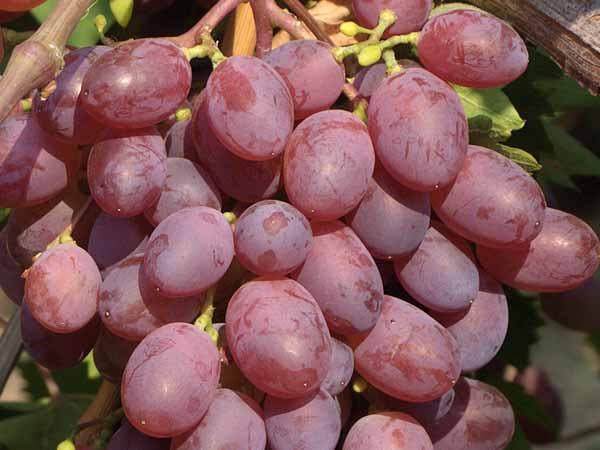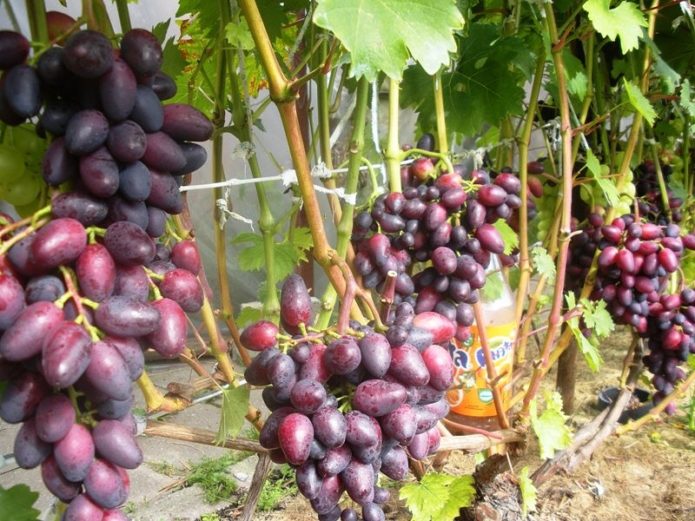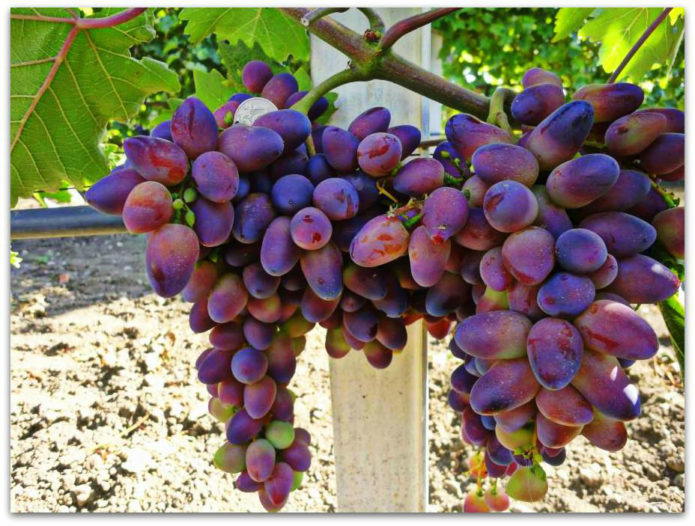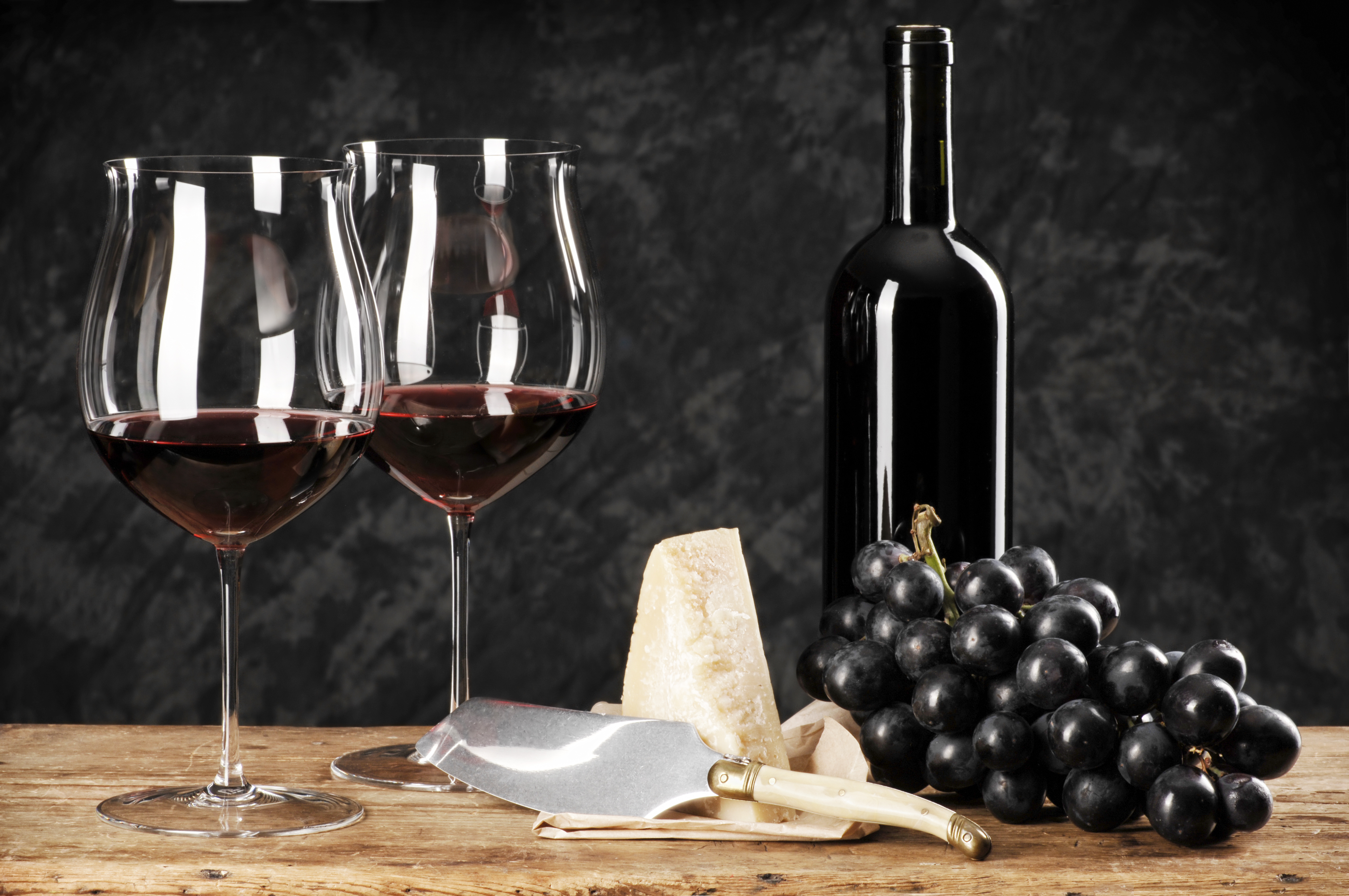Beauty is a new early-ripening table grape variety. This is not to say that its berries are very tasty. But they are so spectacular that the crop has an amazing presentation, for which the variety was attracted by farmers who grow grapes for sale. And since Beauty is also not capricious in leaving, she quickly found her fans.
Content
The history of breeding, description and characteristics of the Krasotka grape variety
A significant part of modern grape varieties are bred not in scientific institutions or large specialized enterprises, but through the efforts of amateur enthusiasts. Evgeny Georgievich Pavlovsky, a miner by profession, belongs to such winegrowers, whose hobby from a young age was first the cultivation of grapes, and then its selection. As a result, today there are about 50 new varieties in his track record, a significant part of which went into the series and found their permanent place both in large vineyards and in numerous summer cottages in various regions of our country and neighboring republics.
Varieties of E. G. Pavlovsky, from the beginning of this millennium actively cooperating with VNIIViV im. Ya. I. Potapenko, are appreciated by specialists for their high adaptability to changeable weather conditions, low susceptibility to pests and diseases, and, at the same time, good taste and visual attractiveness of berries. Its selection is based on the use of well-known strong varieties such as Talisman, Nistru, Victoria, etc.
One of the striking results of the research work of the enthusiast was the creation of the Monarch variety with berries weighing up to 20 g.
The Krasotka variety bears fruit with smaller berries than Monarch, but they have an exceptional presentation, and according to this indicator, the variety fully corresponds to its name. The beauty was obtained in 2004 as a result of pollination of Victoria grapes with a mixture of Amur and European pollen. Therefore, it is difficult to compare it with the numerous “parents” left behind the scenes, but the variety acquired all the best features from Victoria, including early fruiting and resistance to unfavorable climatic conditions.
The table grape variety Victoria is one of those that can be safely recommended for growing to beginners. This very frost-resistant variety is planted even in central Russia, in the Urals and in Siberia:https://flowers.bigbadmole.com/en/yagody/vinograd/vinograd-viktoriya-opisanie-sorta-foto-otzyivyi.html
Beauty's berries ripen simultaneously with the berries of her "mother": from the time the first buds open to harvest, it takes from 105 to 120 days. According to this indicator, some growers classify the variety even as super early, although this is conditional: there are varieties that ripen even faster. Nevertheless, in the southern regions, the first Krasotka berries can be tasted in early August.
The bushes of this grape are medium in size, annual shoots ripen by almost 90%, and the root system is powerful, allowing the plant to do without rain and watering for a long time. Resistance to mildew is slightly higher than average; there is no final clarity about the attitude towards other diseases. The issue of frost resistance is not fully clarified either, but amateurs who have planted the variety even in the north of Belarus note that the usual shelter for the winter is enough for the complete safety of the vine.
The flowers are bisexual, that is, for pollination, Beauty does not need to be on the site of another grape variety. The yield is stable, but very average in terms of the number of berries harvested. The crop is transported well, well, and is stored harvested. However, ripe bunches should never be kept on the bushes for more than 10–12 days: overripe berries burst even in dry weather, the flesh becomes less dense, and the taste quickly deteriorates.
The bunches are conical, rather large, but according to this indicator, the variety is by no means among the champions. In the absence of proper care, they weigh from 300 to 500 g, in conditions of normal agricultural technology - a little more than half a kilogram, and the record holders can overcome the kilogram mark. The berries are located in the bunches rather loosely: the package is considered to be medium loose.
The berries are larger than those of the parent variety, the shape is ovate-elongated, interesting, the size is about 3.0 x 1.9 cm, the weight is 6–8 g. Their coloring is surprisingly interesting. The main tone is dark pink, but towards the tip of the berry, the color gradually turns into purple. The color reaches its peak beauty by the time the fruits are fully ripe. Due to the exceptional beauty of the ripe crop, the variety is very attractive for sale on the market. True, the enticing appearance is not fully confirmed by the taste, which is rated as good, but by no means outstanding.
The pulp is fleshy, juicy, pleasant, but usual taste, refreshing. Muscat signs are moderately expressed, but some gourmets note the presence of a slight vanilla aroma. The skin is dense, edible, the bones are small. The sugar content is low, about 15%, the acidity of the juice is 6–7 g / l. The purpose of the variety is for the summer use of fresh berries.
Features of planting and growing grape varieties Krasotka
Despite the fact that the variety has not yet been fully studied, according to the discussions of the amateurs and professionals who have tested it, we can conclude that it does not differ in significant features in agricultural technology from the vast majority of modern grape varieties of early ripening. It can be propagated both by rooting a lignified cutting (survival rate is close to 90%), and by grafting onto other rootstocks. However, experts note that the choice of rootstock must be approached thoroughly: in a vigorous culture, Krasotka gives a more stable harvest, but loses its resistance to adverse weather conditions.
A vineyard in the country requires the application of strength, but its laying and care does not represent insurmountable difficulties:https://flowers.bigbadmole.com/en/yagody/vinograd/vyirashhivanie-vinograda-v-sredney-polose-dlya-nachinayushhih.html
It is noted that the variety grows on any soil and in any light, but the quality of the crop depends to a large extent on the cultivation conditions. The most worthy harvest Beauty produces in well-lit and sun-warmed areas. Ideal soils are chernozem or nutrient-rich sandy loam with a neutral acidity index. Swampy or saline soils, as well as close standing groundwater are not suitable.
In this regard, before digging a planting hole, they prepare the area around it, fertilizing with humus, peat or manure, as well as adding chalk on acidic soils and sand on clay soils. The pit is not very large: 60 cm is enough in all dimensions, but good drainage at its bottom is required. This is a layer of pebbles or gravel 10-15 cm high. In the case of heavy soils, a vertical pipe is also desirable, led to the zone of future roots of the seedling for irrigation.Filling the pit is usual: the lower half is half-and-half soil with fertilizers, the upper half is clean fertile soil.
When planting several bushes, large distances between them are not required: even a compacted planting is possible (distance 1.2–1.5 m). This is due to the fact that the main vines of the Beauty are oriented upward, for which it is worthwhile to equip strong supports in advance. The same distances are maintained from the foundation of the house if grapes are planted near the wall (preferably from the south side).
Planting is carried out in April, after the establishment of spring weather. The grapes are planted deeply, leaving two buds on the surface. Water the seedling well and mulch the soil around it. In the first year, watering is carried out often, preventing the soil from drying out, watering both into the roots (through a pipe) and in the usual way, over the surface.
Despite the powerful root system and the ability to independently obtain moisture for itself, Beauty requires watering for optimal growth and fruiting, especially in dry weather. Sufficient moisture is especially important during intensive fruit growth, as well as before sheltering bushes for the winter, if the amount of autumn precipitation was insufficient. But 10-15 days before the berries are ready for collection, irrigation should be stopped, otherwise the risk of cracking the berries increases sharply. Mulching the soil helps keep it moderately moist.
The first 2-3 years of feeding are not required, the bush has enough fertilizers applied in preparation for planting. However, in the future it is necessary to add humus (1-2 buckets) in early spring and ash (several liters) during flowering or berry growth. Immediately after flowering, foliar dressing with solutions of mineral fertilizers is also useful.
Pruning grapes is one of the most demanding procedures. In early spring, it is worth cutting out only shoots that have poorly endured the winter, as well as obviously superfluous ones. Throughout the summer, shoots and stepchildren that appear out of place are broken out. Correct pruning of grapes in the fall easier to do after leaf fall. The beauty is cut off medium, leaving from 6 to 8 eyes on the shoots, but a little less can be done, counting that their total number per bush was no more than forty.
One of the troubles of the variety is wasps, and the crop has to be protected from their invasion by all means. This is the destruction of nests, and hanging sweet baits with insecticides, and placing bunches of marketable in various nets. The nets also protect berries from small birds, but they do not protect them from crows.
Since the resistance to diseases has not been completely clarified, preventive treatments of the vine with solutions of the simplest fungicides should not be neglected. In early spring, you can use iron vitriol, later - Bordeaux mixture, and in the phase of several leaves - modern drugs like Ridomil Gold.
It is not possible to find an official notice of the degree of frost resistance of the variety, but judging by the reviews of winegrowers, Beauty can withstand temperatures down to -24 aboutC, that is, according to this indicator, it is among the majority of modern grape varieties. Consequently, in the southern regions, you can hardly shelter it for the winter, and in the middle lane, shelter is required, but not too dense. The vines are removed from the trellises and wrapped in spunbond in the hope that the snow will fall on time. The risk is less if the stacked bunches of vines are covered with spruce branches of coniferous trees.
Video: Beauty grapes on the bushes in early August
Advantages and disadvantages of the variety in comparison with similar
Among the early-ripening grape varieties, there are many, the berries of which are much tastier than that of Krasotka, this list is huge. But if you compare them in appearance, then perhaps no other variety has such spectacular bunches, albeit not very large. Although, of course, all this is not for everybody: someone likes the bunches of the Long-awaited or Sensation more attractive, and someone will say that there is nothing more beautiful than a strict Talisman.And yet, it should be recognized that a highly marketable type of crop should be put in the first place among the advantages of the variety. A relatively complete list of the benefits of this grape looks something like this:
- effective appearance of berries of good taste;
- early and even very early ripening period;
- stable, albeit average in size, yield;
- long-term preservation and transportability of the crop;
- good frost resistance;
- resistance of young shoots to spring frosts;
- increased resistance to mildew disease.
The disadvantages of the variety are:
- poor preservation of unharvested crops on bushes;
- high susceptibility to wasps.
It should be understood that in the process of further study of the variety, both lists may be replenished.
The Sensation grape is so named for a reason: this variety has very beautiful berries that have an attractive presentation and excellent taste, but at the same time, surprisingly simple agricultural technology:https://flowers.bigbadmole.com/en/yagody/vinograd/vinograd-sensatsiya-opisanie-sorta-foto-otzyivyi.html
Reviews
GF Krasotka has very good pulp and good taste. Resistance to mildew is also quite high, and it is imperative to cover the bushes of this gf. Ripening of the vine is good, it ripens in our conditions on August 10-15. The only thing that I do not like is that in our conditions in the grafted culture there is one unpleasant problem - shattering of the ovary. Every year, regardless of weather conditions, flowering and other factors. Sometimes, despite such shedding, it pollinates very well, sometimes (as, for example, last year) - there were no bunches at all, only lumps. Any lotions in the form of spraying with boron-containing preparations do not help. The picture is the same on all bushes in three areas. Therefore, I personally consider this gf unstable.
But on my BEAUTY a light shade of a candy plan appeared. And so the berry is tasty, fleshy, with a crunchy effect ... Let it hang a little more in the bags - it was painfully in love with the wasps ...
GF Krasotka got its name for a reason: berries and clusters are attractive! And the palatability is also at its best: sweet juicy solid pulp with a vanilla flavor will not leave anyone indifferent. On the plus side, the form is declared with disease resistance of 3.5 points, but in our problem area with high constant humidity and poor airflow, I did not even see signs of disease, of course, this is with the standard preventive treatment of the entire vineyard. I get a lot of good feedback from the northern regions on this form: the vine ripens early and along its entire length, the berries pick up sugar well at low temperatures in summer. Bunches of GF Beauty within 500-800 gr. and more, a berry weighing 7-12 grams. in our vineyard.
For those who are raising Pretty Woman, I recommend getting a pig. The piglets love the cracked and immature Pretty Woman. You yourself are unlikely to feast on the Pretty Woman, but the oinky ones eat her for a sweet soul. Plant something better for yourself. At least those varieties that do not pop. I do not recommend messing with unstable grape varieties, especially those whose berries turn into complete trash before ripening.
I read a lot of different things about Pretty Woman: who praises, who scolds, first of all for the crackling of berries. In my two years of observation, I have only positive emotions from her. Resistant to diseases, well tolerated the spring frosts of 2014, strong growth, good ripening of the vine, beautiful brushes, large berries, tasty, cod, thank God, has not yet existed.
The beauty has a very rich harmonious taste in which a floral aroma is very well felt, in the taste there are tones of cherry (reminiscent of the Valery Chalov variety) and vanilla. I did not smell Muscat, although it is possible that the floral scent just clogged the light Muscat scent. Beauty's pulp is dense, the skin is tender. Long on the bush Pretty woman would not advise to keep because of wasps.
Video: winegrower about Beauty's problems
Beauty is a worthy variety of early grapes, amazing with a beautiful view of bunches with berries of an original shape and color. Simple agricultural technology allows you to grow a variety for the sale of berries on the market, because, despite their undistinguished taste, they are in demand due to their striking external beauty.







